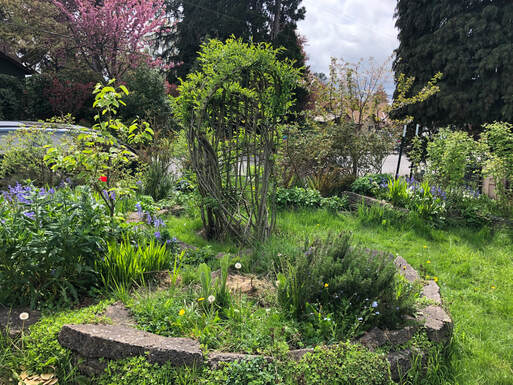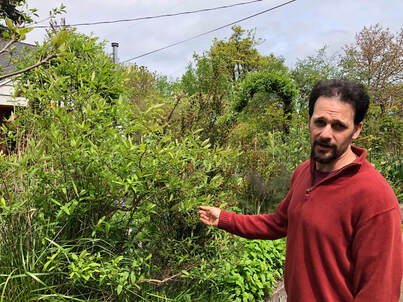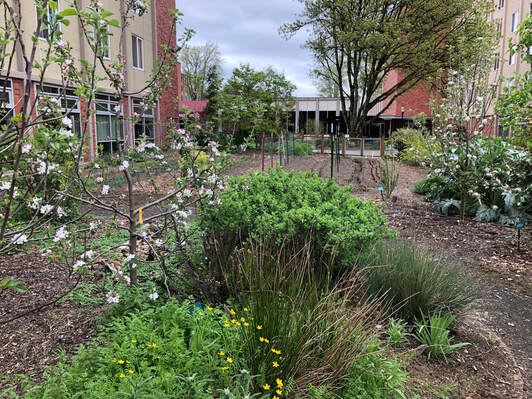Oregon State University Permaculture

As increasing numbers of people across the globe are realizing there must be something more, something solutions-based they can do to positively shift their relationship with others and the natural environment, permaculture is growing in reach – not just in numbers, but also in sectors of our society. As a professor, higher academia is an area of peak interest where permaculture is setting roots.
Andrew Millison, Senior Instructor 1, Permaculture, and I sat at a coffee shop on Oregon State University’s (OSU) campus in Corvallis discussing his journey, permaculture, and how that has taken form at the major land grant university where he works. You may assume he wound up here due to a job posting, but it was actually climate change that prompted his move from Prescott, AZ (16 inches of rain a year), to Corvallis, OR (43.7 inches of rain a year). At 9.5 inches of precipitation a year in Moab, UT, I’ve often worried about climate change and whether our water-strapped community drowning in new development pressure is right for our family. However, I’ve seen too much hope to migrate north in the form of local movements including a 100% renewable electricity commitment by local government, our health department interest in rewriting greywater policy and composting toilet code, community meetings to re-envision our recycling center and waste stream as a whole, community potlucks and more. That said, I and many others can relate to Andrew’s concern and decision, and many more will move north.
Upon arriving in Corvallis, Andrew delivered a talk on peak oil and permaculture at a local food coop. Coincidentally, a student group had just formed a permaculture club and one active student, recently having emerged from a PDC, lobbied to create a permaculture course at OSU with Andrew as the teacher. Yes, past PDC participants have many ripples. The Horticulture Department agreed to trial permaculture and funded one class as an experiment. However, despite great reviews, there was no more funding. The university wasn’t looking to hire a permaculturist, but was open to the idea if Andrew could make a go of it. To solve the financial issue, Andrew launched a summer site-based PDC. This course involved installation projects at the OSU Student Sustainability Center, which had extra funds for Andrew to provide another summer course.
 It was through online courses, however, where Andrew secured his position at OSU. This catalyzed when someone within the State of Oregon: Oregon Housing and Community Services, which builds low income housing throughout the state, had heard of permaculture and Andrew was funded for a year to develop an online course and a large conference for the state agency (Jude Hobbs, Toby Hemenway, and others presented) and the group toured Portland-based permaculture housing developments. This opportunity allowed Andrew to design an online PDC through OSU’s Ecampus and generate a revenue stream. Oregon State University’s Ecampus is ranked third in the country for online education. Shortly after, he produced a PDC for non-credit through Professional and Continuing Education (PACE) and the growing enrollments began impressing administration. Where Andrew has seen the greatest impact and potential, however is through Massive Open Online Courses (MOOC). These are free open source courses, in which he developed Introduction to Permaculture. Students post their work publicly, get feedback from other students around the globe, and must hold themselves accountable for earning their badge of completion. Forty-five thousand people have partaken in the course, and that is just in five iterations. These large numbers helps attract students into Andrew’s online PDC, as students who complete the MOOC receive a 10 percent discount on their enrollment. Students can also enroll in his Advanced Permaculture Design for Climate Resilience online course. He is now working on a Permaculture Water Management four-week MOOC and on two paid courses: Rainwater Harvesting and Permaculture Food Forests.
It was through online courses, however, where Andrew secured his position at OSU. This catalyzed when someone within the State of Oregon: Oregon Housing and Community Services, which builds low income housing throughout the state, had heard of permaculture and Andrew was funded for a year to develop an online course and a large conference for the state agency (Jude Hobbs, Toby Hemenway, and others presented) and the group toured Portland-based permaculture housing developments. This opportunity allowed Andrew to design an online PDC through OSU’s Ecampus and generate a revenue stream. Oregon State University’s Ecampus is ranked third in the country for online education. Shortly after, he produced a PDC for non-credit through Professional and Continuing Education (PACE) and the growing enrollments began impressing administration. Where Andrew has seen the greatest impact and potential, however is through Massive Open Online Courses (MOOC). These are free open source courses, in which he developed Introduction to Permaculture. Students post their work publicly, get feedback from other students around the globe, and must hold themselves accountable for earning their badge of completion. Forty-five thousand people have partaken in the course, and that is just in five iterations. These large numbers helps attract students into Andrew’s online PDC, as students who complete the MOOC receive a 10 percent discount on their enrollment. Students can also enroll in his Advanced Permaculture Design for Climate Resilience online course. He is now working on a Permaculture Water Management four-week MOOC and on two paid courses: Rainwater Harvesting and Permaculture Food Forests.
Why all online? Besides the large numbers and reliant revenue stream, Andrew sees many advantages. He has received feedback from some who do not want a social experience in class, and only want to learn how to design their home site differently. Others have families and can’t dedicate two or more weeks to an in-person experience. Many people live remotely and don’t have access to a PDC anywhere near them. Many are also attracted to the legitimacy that a PDC issued from a major university carries. Thus, online has allowed him to reach a wider pool of people.
When describing permaculture in an elevator pitch, Andrew says “sustainable land design.” From his Introduction to Permaculture course page, the definition states “Permaculture design is a method of landscape planning that can be applied to anything, from a home garden or farm to a city block or entire village. Permaculture uses design principles from nature itself and takes into account such things as how indigenous people use the land; how water, fire and wind flow through the land; and how soil, water, vegetation, buildings and habitats can be managed in a stable and enduring way.” His goal in permaculture is “to elevate permaculture design further into mainstream knowledge and discussions so this valuable design system can be used to transition civilization to a future with clean water, safe and abundant food, renewable energy and resources, healthy watersheds, and prosperous people and ecosystems.”
Working in higher academia, I wondered if Andrew liked the word, ‘permaculture.’ He does. “I think that the word now encompasses a powerful vision…it’s almost a gateway to a possible reality…The meaning behind permaculture and the imagery associated with that meaning is developed and just gets bigger.” When students leave any of his courses, Andrew hopes they can “put on their permaculture glasses” and see the world through a solutions-based, whole systems lens. From there, “I want them to have actual, actionable tools at their disposal”
Despite his incredible enrollment numbers, support has not been ubiquitous. “I would say I do not have blanket administrative support. All of the administrative support I have, I’ve had to build relationships through mutual trust and prove that I can be self supportive and economically generative overtime, and then suddenly they want to support me because there is reciprocity and respect.”
Now, after eight years of incremental work, Andrew has a Fulltime Equivalent (FTE) position. The vast majority of that position is funded through his online course income, and the horticulture department covers a portion of his position. In his promotion process to Senior Instructor 1, Andrew recounts his presentation to the Horticulture Department’s faculty “‘I’m not really teaching [students] horticultural techniques. I leave the details of tree fruit breeding, vegetable production, greenhouse management, and plant pathology to you folks.’ My students are taking soil science, they are taking landscape maintenance, they are taking berry and nut crop cultivation, they are taking organic agriculture. They are taking this wide sweep…I’m teaching them a design system to help them organize and use the things they are learning in all of your classes.” I was excited to hear this framing. As a whole-systems design framework, permaculture could be housed in horticulture, in English, watershed science, business, or any major because it brings together what students are learning into a solutions-based action framework. I see potential here and am excited about where we will take permaculture in higher academia.
To discover more about Andrew and Oregon State University’s permaculture courses, visit: https://horticulture.oregonstate.edu/users/andrew-millison

Recent Posts

